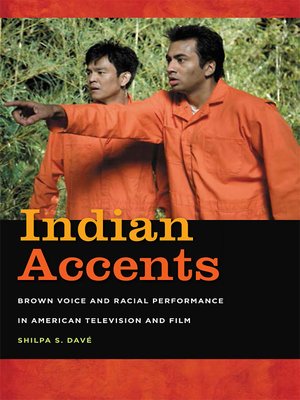Indian Accents
ebook ∣ Brown Voice and Racial Performance in American Television and Film · Asian American Experience
By Shilpa S. Dave

Sign up to save your library
With an OverDrive account, you can save your favorite libraries for at-a-glance information about availability. Find out more about OverDrive accounts.
Find this title in Libby, the library reading app by OverDrive.



Search for a digital library with this title
Title found at these libraries:
| Library Name | Distance |
|---|---|
| Loading... |
Amid immigrant narratives of assimilation, Indian Accents focuses on the representations and stereotypes of South Asian characters in American film and television. Exploring key examples in popular culture ranging from Peter Sellers' portrayal of Hrundi Bakshi in the 1968 film The Party to contemporary representations such as Apu from The Simpsons and characters in Harold and Kumar Go to White Castle, Shilpa S. Dave develops the ideas of "accent," "brownface," and "brown voice" as new ways to explore the racialization of South Asians beyond just visual appearance. Dave relates these examples to earlier scholarship on blackface, race, and performance to show how "accents" are a means of representing racial difference, national origin, and belonging, as well as distinctions of class and privilege. While focusing on racial impersonations in mainstream film and television, Indian Accents also amplifies the work of South Asian American actors who push back against brown voice performances, showing how strategic use of accent can expand and challenge such narrow stereotypes.| Cover Title Page Copyright Page Contents Illustrations Acknowledgments Introduction. Rethinking Accents in America 1. South Asians and the Hollywood Party: Peter Sellers and Brownface Performances 2. Apu's Brown Voice: The Simpsons and Indian American Accents 3. Animating Gandhi: Historical Figures, Asian American Masculinity, and Model-Minority Accents in 4. Indian Gurus in the American Marketplace: Consumer Spirituality in The Love Guru and The Guru 5. The (Asian) American Dream: Harold and Kumar Go to White Castle and the Pan-Ethnic Buddy Film 6. "Running from the Joint": Harold and Kumar Escape from Guantanamo Bay and Comic Narrative after 9 Epilogue Notes Index | "A truly innovative use of 'accents' as a methodological entry into understanding where South Asians are positioned within America and American popular culture. Persuasively argued and full of many sharp insightful moments, Indian Accents will be invaluable to scholars of American studies, Asian American studies, ethnic studies, and media studies." —Gita Rajan, coeditor of New Cosmopolitanisms: South Asians in the U.S
"Davé brilliantly studies the racialized, classed, and nationalistic codes of Orientalist and model minority representations with an underwriting analysis of heteronormative masculinity... Davé does crucial critical work in diasporic visual culture."—Asian Diasporic Visual Cultures and the Americas
"This book offers a much needed corrective to the portrayal of South Asian masculinity in American popular culture and is, therefore, a valuable addition to the field."—American Studies
"Shilpa Davé was able to capture the multidimensional elements of representations of people of color that go beyond visual markers of identification but also include sonic components to ethnic characters in media. Her innovative application of the double meaning of the word 'accent' opens a new level of analysis of ethnic representation in film and media studies and ethnic studies." —Journal of Asian American Studies
|Shilpa S. Dave is is Assistant Dean, College of Arts and Sciences, and an assistant professor of media studies and American studies at University of Virginia.







